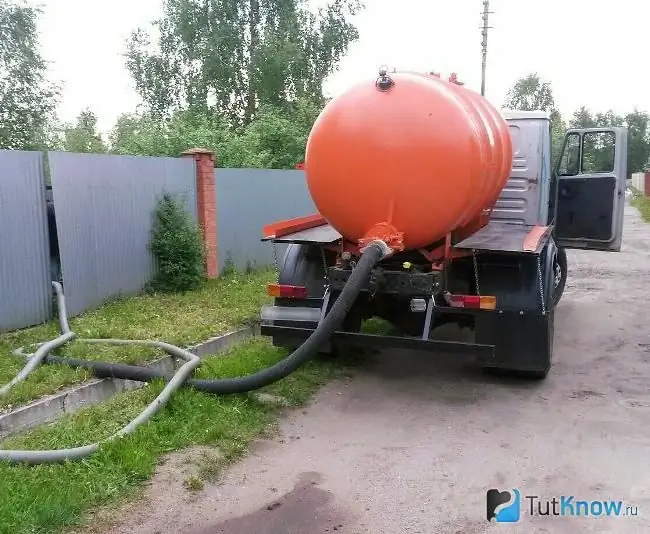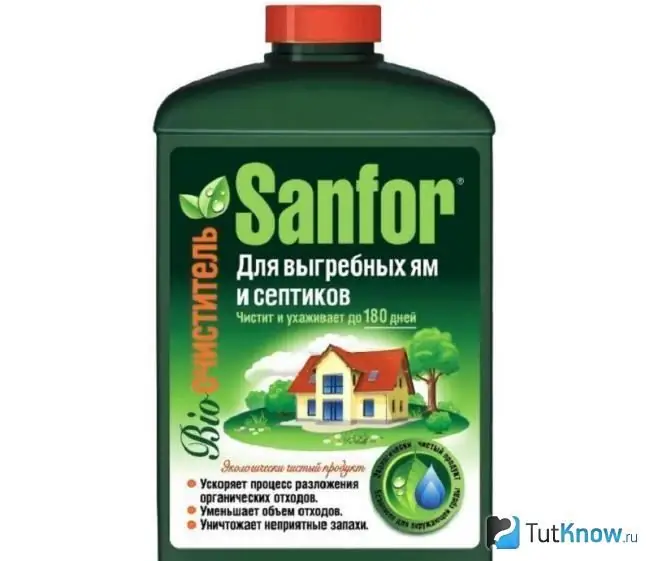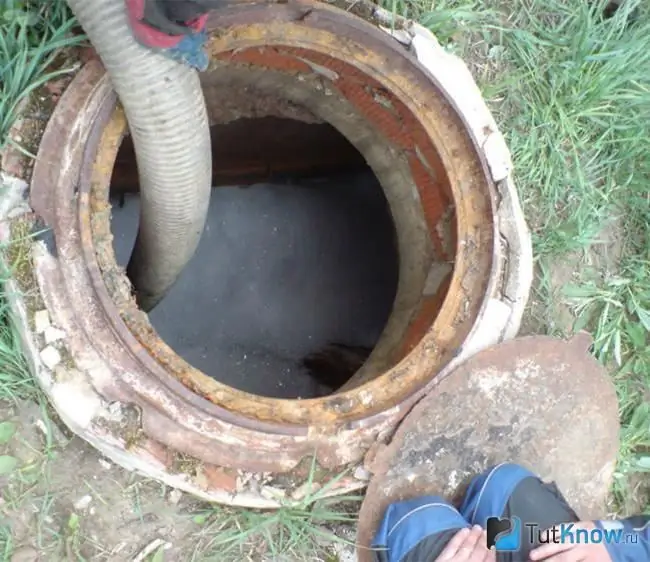- Author Arianna Cook [email protected].
- Public 2023-12-17 14:23.
- Last modified 2025-01-23 09:40.
Cleaning the cesspool in three ways. Features of each method and the necessary tools. Choice of cleaning options and helpful tips. Cleaning a cesspool is an unpleasant process, but it is important to keep it working in terms of waste disposal. Indeed, unlike the townspeople, the owners of country houses themselves have to solve such problems. About how to properly clean the cesspool with your own hands, our today's material.
Sump Cleaning Planning

The principle of operation of the cesspool is simple: sewage, passing through a wide sewer pipe, falls into a special container and accumulates in it. If it is completely sealed, it will fill up quickly. If such a storage device has a filtering bottom or is connected to an absorbing well, drains will not have to be pumped out often, because their liquid fraction, draining through the bottom filter, penetrates into the ground and undergoes additional treatment in it. But the accumulation of insoluble sludge with a bad smell in the sump is inevitable. Therefore, you need to get rid of it periodically.
Modern methods of cleaning any tanks, including sewage, expand the capabilities of their owners, making their work safer and more comfortable. Removal of sludge, sediment and odor can be done in three ways: mechanical, chemical and biological.
Choosing any of them, you need to take into account the availability of the method, its cost and environmental safety. The type of container should be recognized, since they are very different in design and material of manufacture.
It is important to take into account the volume of the drain pit, the presence of a bottom or drainage layer in it, the composition of the effluent entering the system, and the availability of an access path for the car of the sewer service. Having such information will help in choosing further actions. In the process of independent work, you should be extremely careful. So, for example, after cleaning a filter-type cesspool, it may be necessary to restore the drainage layer at its bottom. And if the choice falls on the use of a biological method, the composition of the wastewater will have to be taken into account.
Cleaning the sewer pits is not always necessary. This is especially true for small tanks for country toilets. Often they are simply buried, adding a preparation for composting to the contents beforehand. After a certain time, an apple tree can be planted near such a hole, for example, and it will bear fruit excellently. And the toilet is then transferred to the installation site of the new tank.
Cesspool cleaning methods
There are 3 ways to clean the cesspool - mechanical, biological and chemical. Let's consider the features of each of them.
Mechanical cleaning

If absolutely necessary, you can even clean the sump of silt and sediments manually using a bucket and a rope. The owners of small summer cottages do just that. But such work is unpleasant, it requires special organization and suitable equipment.
Before performing manual cleaning, you must wear a special suit or clothing made of dense material, which you will not mind throwing away later. It is needed to protect the skin, as waste water is chemically aggressive.
In addition, you will need a gas respirator. It is essential for respiratory protection. And it's not just the stench emanating from the pit. Sewer fumes contain methane and is hazardous to inhale. This is a good reason not to clean up the inside of the pit alone. If the worker who is below suddenly loses consciousness, breathing in poisonous fumes, then the partner will be able to pull him out and provide assistance. In addition to workwear and a respirator, you should also wear rubber boots and gloves.
Prepare a sealed container before work. It will be needed to dispose of sewage extracted from the cesspool. Later they need to be taken out to the place designated for them.
It is unpleasant, long and unsafe to be engaged in manual cleaning of a cesspool from silt. If funds allow, it is better to pump out wastewater into a container not with a bucket, but with a fecal pump. This will speed up the process, and there will be less contact with impurities. The apparatus should be flushed periodically, as it gradually becomes clogged with insoluble waste.
It is much more convenient to perform mechanical cleaning of the sump with sewage equipment. This is a car equipped with a cistern, a powerful pump and pressure hoses through which sewage is pumped out of the pit. The distance between the car and the cesspool should not exceed 4 m.
Pits, the depth of which is more than 3 meters, are not serviced by sewage trucks. This should be known, although sedimentation tanks of such depth are almost never found. Even at the stage of construction of a cesspool, it is useful to use such a nuance: the fee charged by the sewer workers includes the cost of the call, and not the volume of waste that they pumped out. For the sake of economy, in the future, a sump of such a volume should be made so that the amount of its drains to be pumped out corresponds to the capacity of the car's tank.
When using a summer cottage and a cesspool only in the summer, it will be necessary to call the sewers much less often than with a permanent residence year-round with a whole family, actively using showers and other devices that consume water. This service cannot be called very cheap. But it solves the main problems - it allows you to perform effective cleaning and organize waste disposal.
Biological treatment

Microorganisms serve as the basis for biological products for wastewater treatment and treatment. As a result of their activity, solid fractions of sewage are converted into a turbid liquid, which is then easy to pump out.
By their origin, bacteria for cleaning cesspools are natural and cultural. The former develop independently in the environment, while the latter are grown artificially in laboratories. Some of them even adapt to the chlorine that the effluent may contain. Some products are sold in liquid form, others are granular. They must be dissolved in clean water in advance.
After entering the humid environment of the sewage system, "dormant" bacteria are activated and begin to diligently process organic waste. Other microorganisms that cause a specific odor in the sump are killed.
Effective work of biological products is possible only at a positive temperature from 4 to 30 degrees. Before using them, you must read the instructions. After penetration into the liquid, bacteria need a couple of hours to activate, and already in 4 hours they will successfully remove the unpleasant odor.
With the help of biological products, the fats contained in the effluents, vegetable peelings, feces and other organic waste are processed. At the same time, the impurities decrease in volume and lose their toxicity. But soap residues when using cleaning agents are not recommended to be poured into a sump. In such an environment, beneficial bacteria are killed and cleaning becomes ineffective.
If biological products are used constantly, the need for pumping and disposal of effluents may disappear altogether. After the introduction of such an agent into the sump, its drainage layer becomes clean, and the water freely goes into the ground. The remaining contents of the cesspool are completely safe. It can be removed and then used as garden fertilizer. Biological products are absolutely safe and do not corrode the material of the cesspool body: metal, brick, PVC or concrete.
According to the method of exposure, biological preparations are of 2 types - septic and antiseptics. The former cause the decomposition of sewage and are a mixture of cultured bacteria with enzymes and yeast materials. The latter disinfect waste and remove odors.
Let's take a look at the most popular means of biological cleaning of cesspools:
- "Septic-biogranules" … Consists of enzymes and artificial microorganisms. They convert sewage into a homogeneous, odorless liquid that can be pumped out. To maintain the sump in working order, it is recommended to use the substance at least once a week. Release form - granules.
- "Septic-10" … The agent is used to remove sludge and restore the possibility of biological treatment, which was disturbed due to the discharge of chemical detergents into the sewer together with water. The form of the product is liquid.
Chemical cleaning

The principle of action on wastewater of biological and chemical preparations is the same - decomposition and removal of odor. But there is an important difference: biological agents are useless in winter, since they are able to work, as mentioned above, only at positive temperatures. Chemicals are universal, although they also have their disadvantages.
If you need to clean the cesspool in winter, you should use the advantages of chemicals:
- These sump cleaners can operate in frost or temperature extremes.
- They have excellent resistance to the aggressive environment of effluents contaminated with soapy water or detergents for dishes, plumbing fixtures, and laundry.
- They effectively decompose solid fractions of sewage and eliminate the smell of sewage.
However, not all cesspool cleaning chemicals are environmentally friendly. This is their disadvantage.
Almost all chemicals are aggressive enough. Thanks to this, they successfully cope with impurities of any kind. But such substances are not suitable for cleaning metal cesspools, since they also corrode steel successfully. Among the most popular agents of this type are ammonium compounds, formaldehyde, bleach and nitrate oxidants.
Formaldehyde
is considered the most inexpensive substance, which does not interfere with its effectiveness. However, due to its high toxicity, it has hardly been used recently.
Ammonium salts
are fast-acting remedies. They completely rid the cesspool of stench, however, in an environment where there is a lot of chemical waste, their effectiveness decreases.
Nitrate oxidants
contain the components of the fertilizer of the same name. This helps them break down solid waste in the drains and combat the odor of sediment on the bottom and walls of the sump. The price of such drugs is quite high, although this is quite reasonable. Among all products belonging to this group, nitrate oxidants are the safest in terms of ecology. They have an enviable resistance to all aggressive substances. In terms of safety and performance, they are ideal for chemical cleaning of cesspools.
Recommendations for choosing a method for cleaning a cesspool

When choosing a pit cleaning method, it is recommended to imagine a specific situation. For example, if you want to clean the cesspool under the yard toilet, you need to buy drugs that can dissolve not only its contents, but also paper. That is, a biological product or a nitrate oxidizer is ideal.
It should be noted that the use of biological or chemical agents is always much more expensive than mechanical pumping of wastewater. But this procedure is easier and less time consuming.
If you have a garden or vegetable garden, then sewage can not be disposed of, but turned into fertilizer. This can be done by biological products for cleaning cesspools.
How to clean a cesspool - watch the video:

We hope that after reading this article, the maintenance of an autonomous sewage system will not create problems for you. Good luck!






